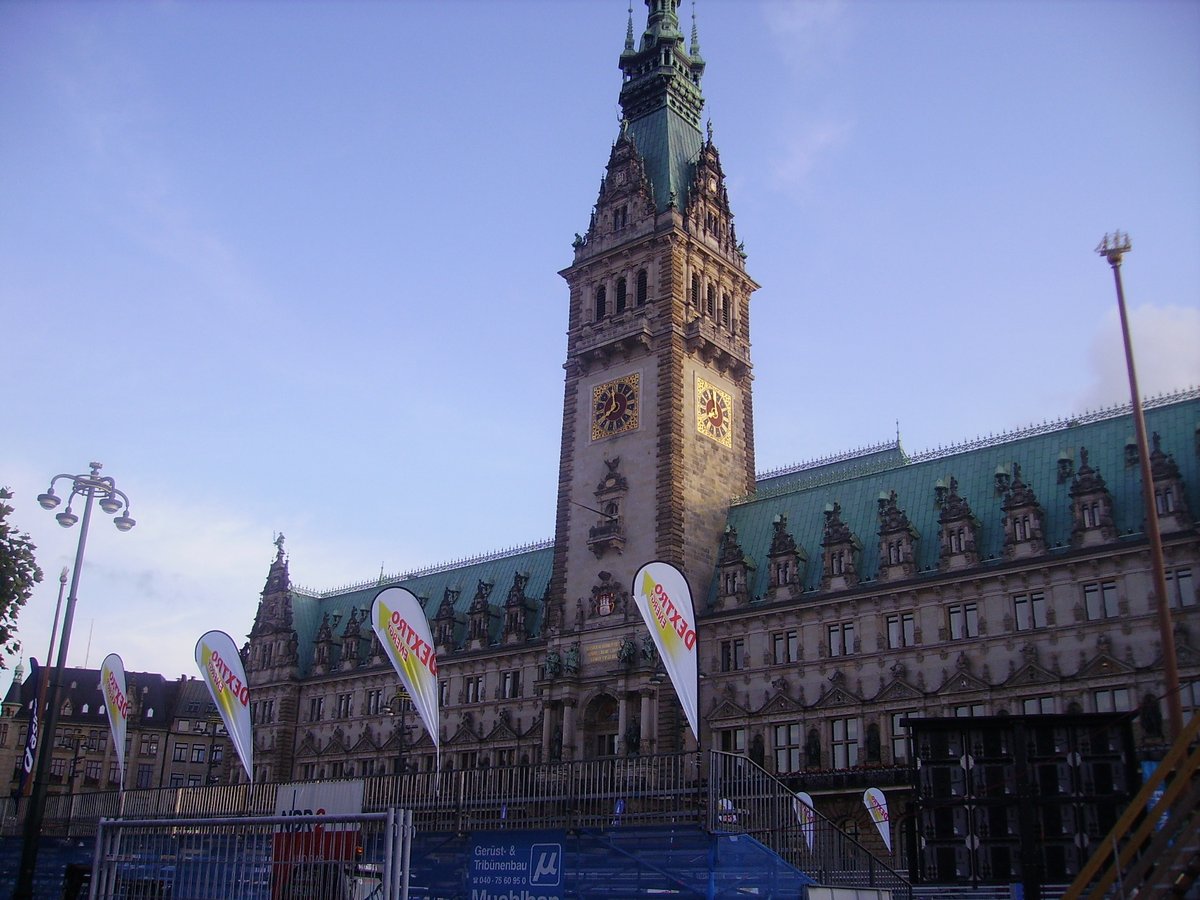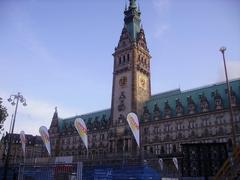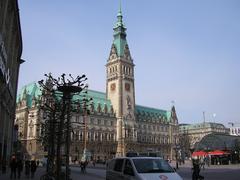
Visiting Hamburg City Hall: Guide, Tickets, Hours, and Tips
Date: 14/06/2025
Introduction: Hamburg City Hall’s History and Significance
Hamburg City Hall (Hamburger Rathaus) is one of the city’s most iconic landmarks, representing both Hamburg’s resilience and its rich historical tapestry. Located in the heart of the Altstadt, the neo-Renaissance building was constructed between 1886 and 1897 after the Great Fire of 1842 destroyed the original city hall and much of Hamburg’s old town. The new Rathaus arose as a symbol of recovery and ambition, and today it serves as the seat of the First Mayor, Parliament, and Senate, while also standing as a vibrant cultural and architectural attraction (Hamburg City Hall official website; History Hit; Travel In Culture).
The City Hall’s grand façade, adorned with statues of emperors and crowned by a 112-meter tower, is a testament to Hamburg’s Hanseatic heritage. Its 647 rooms—more than those in Buckingham Palace—are filled with murals, frescoes, and coats of arms, each narrating a segment of the city’s storied past. The Italian-style inner courtyard, with the Hygieia Fountain, commemorates Hamburg’s recovery from the 1892 cholera epidemic, further underscoring the building’s symbolic significance.
This guide provides up-to-date information on visiting hours, ticket options, guided tours, accessibility, and nearby attractions, ensuring you make the most of your visit to one of Germany’s most celebrated civic buildings.
Contents
- The Great Fire of 1842: Loss and Resilience
- Designing and Building the New Rathaus (1886–1897)
- Neo-Renaissance Architecture and Symbolism
- Inauguration and Historical Milestones
- The Rathaus Through the 20th Century
- Modern-Day Visitor Information
- Visiting Hours and Tickets
- Guided Tours and Accessibility
- Travel Tips and Nearby Attractions
- Local Traditions
- FAQ
- Conclusion
The Great Fire of 1842: Loss and Resilience
In May 1842, a devastating fire swept through Hamburg, destroying its original city hall and much of the old town (Turbopass; Wikipedia). The loss was more than architectural—it struck at the heart of Hamburg’s identity as a free Hanseatic city. For over forty years, city officials operated from temporary quarters while the city debated how best to rebuild, reflecting both political complexity and the scale of recovery required (History Hit).
Designing and Building the New Rathaus (1886–1897)
After decades of deliberation, construction began in 1886. Led by a consortium of architects headed by Martin Haller, the project was ambitious in scale and budget, ultimately costing the equivalent of around €80 million today (Wikipedia). The building rests on over 4,000 oak piles, stabilizing it on the soft banks of the Alster Lake (Hamburg.com). The façade stretches 133 meters, and the central tower soars to 112 meters—making it a dominant feature of the city skyline (The Crazy Tourist).
Neo-Renaissance Architecture and Symbolism
Hamburg City Hall is a masterpiece of neo-Renaissance design, chosen to reflect the city’s prosperity and independence (Turbopass). The elaborate façade features 20 statues of Holy Roman emperors, allegorical sculptures, and coats of arms that highlight Hamburg’s heritage (Hamburg.de).
Inside, the 647 rooms include the Grand Ballroom—46 meters long and decorated with paintings chronicling Hamburg’s history—and the Senate chamber, distinguished by its glass roof. The inner courtyard, reminiscent of an Italian piazza, features the Hygieia Fountain as a tribute to the city’s triumph over the cholera epidemic (Travel In Culture; Hamburg.com).
Inauguration and Historical Milestones
The new City Hall was inaugurated on October 26, 1897, in a ceremony attended by dignitaries from across Europe (Wikipedia). Since then, it has served as the seat of Hamburg’s government and hosted key events, from the signing of the Hamburg Constitution in 1952 to state visits by international leaders such as Queen Elizabeth II and Emperor Haile Selassie I (History Hit). The Rathaus survived World War II largely unharmed, allowing it to remain the city’s political and ceremonial heart.
The Rathaus Through the 20th Century
Throughout the 20th century, the Rathaus played host to both solemn and celebratory events. It was a site of public mourning during the 1962 North Sea flood and a venue for jubilant celebrations, including major football victories (Wikipedia). The building also continues to serve as a hub for civic life, hosting exhibitions, concerts, and the annual Matthiae-Mahl banquet, the world’s oldest such event (Hamburg.de).
Modern-Day Visitor Information
Visiting Hours and Tickets
- Opening Hours: Monday–Saturday, 9:00 AM–6:00 PM; closed on Sundays and public holidays. Check the official website for any updates or special closures.
- Tickets: Entrance to the main hall and courtyard is free. Guided tours of the interior require tickets (~€5–10 for adults), with discounts for students and children (Hamburg Touring).
- Booking: Reserve tickets online or at the Rathaus visitor center. Tours are popular, especially during peak seasons.
Guided Tours and Accessibility
- Tour Details: Guided tours in German and English last about 40–60 minutes and cover highlights such as the Grand Ballroom, Senate chamber, and inner courtyard.
- Accessibility: The building is fully accessible with ramps and elevators. Visitors with mobility needs should notify the staff in advance to ensure assistance.
- Parliamentary Sessions: Visitors can attend plenary sessions by prior registration; these are held every two weeks on Wednesdays (Hamburg.de).
Travel Tips and Nearby Attractions
- Getting There: The Rathaus U-Bahn station is immediately adjacent. Several bus lines and S-Bahn services stop nearby.
- Rathausmarkt: The lively square in front of City Hall frequently hosts markets, festivals, and concerts.
- Nearby Attractions: Binnenalster lake, Alsterarkaden, Jungfernstieg promenade, Speicherstadt warehouse district, and the Elbphilharmonie concert hall are all within easy walking distance (That’s What She Had; Destination Abroad).
- Dining: The basement Parlament Hamburg Restaurant serves traditional German cuisine in a historic ambiance.
Local Traditions
A unique Hamburg tradition involves unmarried men sweeping the Rathaus steps on their 30th birthday—an endearing local custom you might witness during your visit (History Hit).
FAQ: Hamburg City Hall Visitor Information
What are the opening hours?
Monday–Saturday, 9:00 AM–6:00 PM. Closed Sundays/public holidays. Check the official website for updates.
Are guided tours available?
Yes, in German and English, several times daily. Advance booking is recommended.
Is the building accessible?
Yes, with ramps, elevators, and staff assistance.
Are tickets required?
Entry to the main hall and courtyard is free. Guided tours require a ticket (€5–10 for adults).
Can I take photos?
Photography is permitted in most areas but may be restricted during official events or in some rooms.
How do I get there?
Take the U-Bahn (Rathaus station), S-Bahn, or bus. Public transport is recommended due to limited parking.
Can I attend a parliamentary session?
Yes, by prior registration. Sessions are typically every two weeks on Wednesdays.
Visuals and Media
- Include high-quality images with descriptive alt tags such as “Hamburg City Hall façade,” “Interior of Hamburg City Hall Grand Ballroom,” and “Hygieia Fountain in courtyard.”
- Virtual tours are available on the official website for pre-visit exploration.
Practical Tips
- Plan for 1–2 hours: A guided tour and exploration of the surroundings will fill this time.
- Combine with local attractions: The central location makes it easy to visit other historic sites and enjoy local dining.
- Best time to visit: Spring, early summer, or December for the famous Christmas market.
- Language: Tours in both German and English.
Conclusion
Hamburg City Hall is a must-visit destination that perfectly blends history, architecture, and vibrant civic life. Whether you’re discovering its ornate interiors, attending a guided tour, or simply enjoying the lively Rathausmarkt, you’ll leave with a deeper appreciation for Hamburg’s spirit and heritage. For the latest visiting hours, ticket options, and event information, consult the official Hamburg City Hall website.
Plan your visit, book a tour in advance, and download the Audiala app for immersive audio guides. Follow us on social media for more insider tips and travel inspiration. Enjoy your journey into Hamburg’s heart!
Sources and Further Reading
- Turbopass: The Town Hall of Hamburg, Germany – A Guide to Its History and Architecture
- Wikipedia: Hamburg City Hall
- Travel In Culture: Things to Do in Hamburg – Port City
- The Crazy Tourist: 25 Best Things to Do in Hamburg
- TravelSetu: Hamburg Rathaus Tourism Guide
- History Hit: Hamburg City Hall
- Hamburg Touring: Hamburg City Hall
- That’s What She Had: One Day in Hamburg Itinerary
- Destination Abroad: Is Hamburg Worth Visiting?





















































































